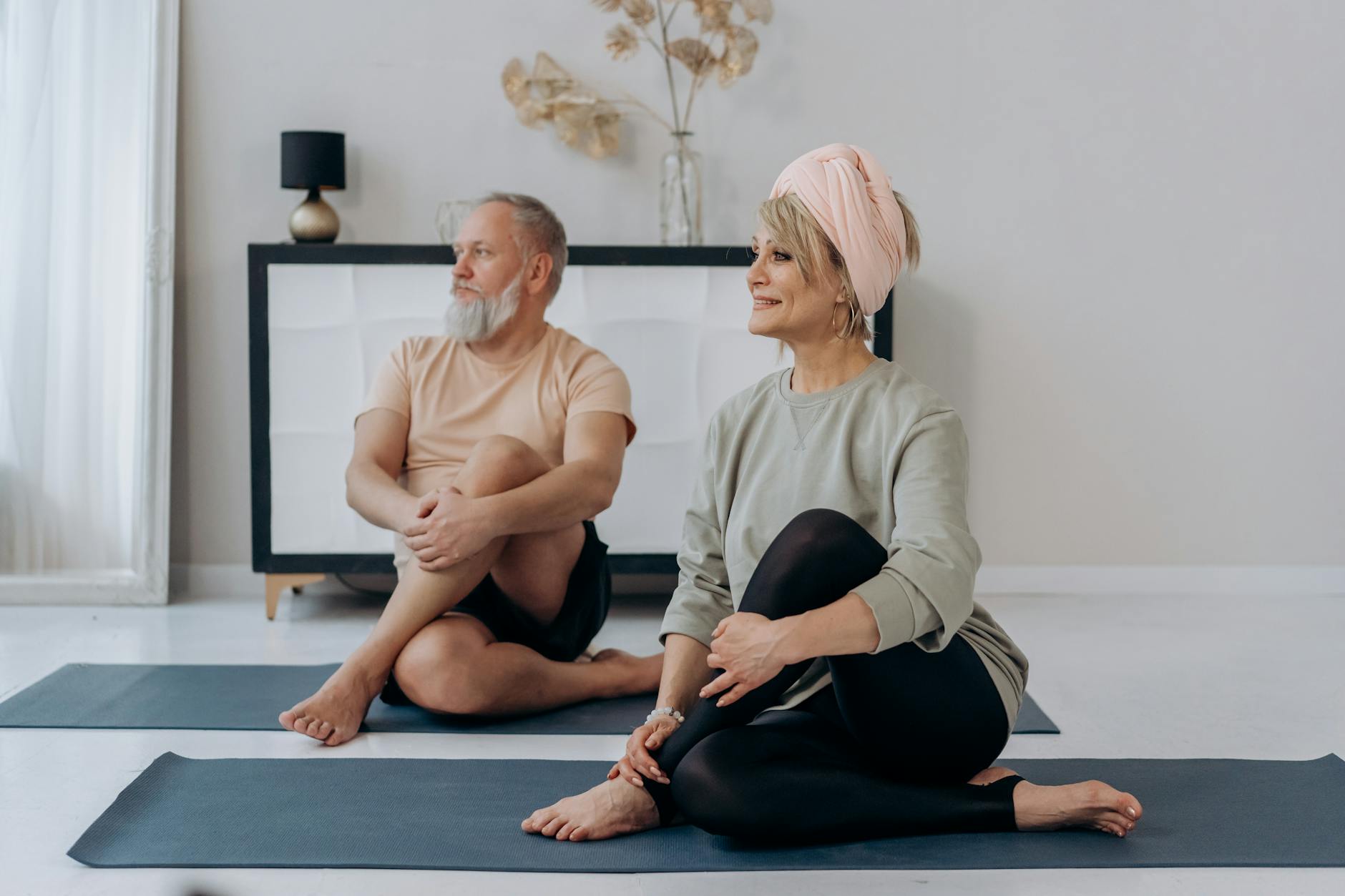How can I learn more about how to be healthy as I age?
Adults over the age of 50 may require different nutrition than young adults. The National Institute on Aging (NIA) has extensive information on the foods and beverages that older individuals should consume, including sample meals, grocery shopping ideas, and suggestions for overcoming barriers to healthy eating.
Physical activity
Physical activity is beneficial for your health at any age. If you have never been active before, beginning regular physical activity now may help you improve your strength, balance, flexibility, and endurance—the ability to move for long periods of time without stopping.

Being physically active may help you maintain a healthy weight and avoid chronic health issues as you age. It may help you manage arthritis, anxiety, and depression. It may help manage diabetes and high blood pressure. Being physically active may also help you live independently for a longer period of time by maintaining your health.
All activities count, including those you do anyhow, such as walking the dog, vacuuming the home, or raking the leaves. Things that aren’t difficult or unpleasant, such as dancing or jumping rope with your grandchildren, also count. As you become older, you’ll learn more about different strategies to stay physically active.
Being active can be difficult if you are unable to move freely, require a cane or walker, or have major health issues. However, there are some things that can help you get more exercise. For example, softly elevating your arms or legs on a daily basis may improve your flexibility.
When should I consult my doctor regarding physical activity?
According to recent studies, healthy older persons who wish to gradually increase their physical activity do not need to consult with a healthcare practitioner first. However, your healthcare expert may be able to advise you on the types of activities to consider and how to progress at a safe and consistent rate.
Check with your healthcare professional.
If you are already being treated for a chronic ailment, such as type 2 diabetes, heart disease, osteoarthritis, high blood pressure, a physical impairment, or a cancer survivor
If you have chest pain or pressure, dizziness, or joint pain
If you want to know how to prevent getting hurt
If you experience new health concerns while raising your activity level.
Your health care provider may recommend and assist you in planning the types and levels of physical activity that are appropriate for you.
How much and what kind of physical activity do I need?
Keep in mind that any physical activity is better than nothing at all, so try to move as much as you can.
Healthy older persons should routinely engage in 5 sorts of activities.
Aerobic exercises are commonly known as endurance or cardio.
Activities that strengthen muscles.
Activities that Improve Balance
Activities that Increase Flexibility
Activities that combine more than one form of physical exercise, such as aerobic, muscle-building, and balance training (known as “multicomponent” activities).
If you have a significant health condition, such as diabetes or heart disease, be aware of how it may limit the amount of activity you may safely perform.
You can distribute your activities throughout the day or week, whichever works best for you. According to studies,spacing out your activities over at least three days a week can enhance your health, reduce your risk of getting hurt, and keep you from feeling exhausted.
Many activities provide more than one advantage. Water aerobics with weights provides both aerobic and strengthening benefits. Yoga blends aerobics, balance, flexibility, and strength. Select activities that you enjoy.
Begin softly and gradually increase your physical activity level. For elderly folks, a fitness practice may be started at home with everyday things.
If you’re having problems starting or remaining physically active, here are some recommendations to help you overcome obstacles to being more active. An activity record can help you track your progress and be conscious of how you feel while you’re active.
Physical activities
Aerobic activity.
Aerobic activity (cardio or endurance training) uses your large muscle groups (chest, legs, and back) to increase your heart rate and respiration.
If you continue your activity over an extended period of time, it becomes aerobic.
Moderate-intensity aerobic activity allows you to talk but not sing.
Vigorous-intensity aerobic activity requires you to pause for breath every few sentences.
Benefits
- Improves the strength and fitness of your heart, lungs, and blood vessels.
- Increases your endurance.
- It may reduce the risk of heart disease, stroke, diabetes, certain malignancies, and anxiety.
What You Can Do:
- Take a vigorous walk or bike ride. (Remember your helmet.)
- Do housework or gardening.
- Participate in yoga, tai chi, water or chair aerobics, or other activity classes for seniors. Local community or senior centers may provide free or subsidized classes.
How long and how often
- Aim for at least 150 minutes per week of moderate-intensity aerobic exercise.
- If you participate in vigorous-intensity aerobic activity, aim for at least 75 minutes each week.
- Exercise for any number of minutes at a time, even ascending a few flights of stairs.
Muscle strengthening activity
Muscle-strengthening activities require your muscles to undertake more work than they are used to doing.
These activities may involve your legs, hips, chest, back, abdomen (stomach area), shoulders, and arms.
You can exert a moderate or greater amount of effort.
Benefits
- Increases bone and muscular strength.
- Helps keep your muscles strong while decreasing weight.
- Improves your equilibrium.
What You Can Do:
- Slowly raise and drop the arms and legs for many counts. You can even do this while sitting.
- Dig in the garden, rake, or push the lawn mower.
- Carry large goods such as groceries or laundry.
- Participate in a lesson that uses weights and exercise bands.
How long and how often
- Aim for at least two days per week.
- There is no advised time limit; simply stop when it becomes tough to do the next exercise.
- Take it slow: gradually increase the amount of weight, number of sets or motions, and number of days per week.
Balance Improving Activities.
Balance exercises demand you to maintain control of your body while moving.
They may help to strengthen your abdominal, chest, lower back, hips, arms, and legs.
Benefits
- Helps you stay stable on your feet.
- Decreases the danger of a fall or injury.
- Increases your strength at the same time.
What You Can Do:
- Try walking from heel to toe in a straight line.
- Try standing on one foot.
- Practice standing from a seated posture.
How can I get more physically active?
Choose an activity you enjoy and set tiny goals, such as “I’ll go for three 10-minute walks this week.”
“Start low and go slow.” Gradually increase the total amount of time active, the number of days active, and the intensity of each activity.
If you live in a retirement home or assisted-living, inquire whether the fitness center provides a free health checkup and fitness program.
Begin a walking or other activity group with friends or family near where you live, work, or worship.
Remember to follow these safety tips!
Consult your doctor about safe ways to improve your physical activity.
Remember to start lightly and progress to more intensive activity over time.
Wear sturdy shoes.
Stop exercising if you get pain, dizziness, or shortness of breath.
Consume fluids.
Exercise outside during daytime hours with a friend. Be cautious when crossing the roadway.
How do I start or maintain an activity program that works for me?
Start slowly and gradually increase your goals as your endurance and strength improve over time. To begin, you can do arm and leg workouts without using any weights. As you grow, you can add hand-held weights, such as soup cans, to boost your strength.
As you improve your fitness, gradually increase your pace, duration of activity, and number of days per week.
The NIA provides advice on diet, exercise, and safe aging. Try these suggestions to get started with a fitness regimen that works for you.
Being good to yourself.
Older folks may feel lonely, unhappy, despondent, or anxious as a result of life changes, loss of loved ones, health problems, caring for other family members, or financial difficulties. Being kind to yourself can help you improve your lifestyle habits, “get up and go,” and ability to deal with the stresses of daily life.
Here are some tips to be good to yourself.
- Stay in touch with family, friends, or past coworkers to keep yourself involved and motivated.
- Visit your doctor on a regular basis and discuss any issues you have.
- Get sufficient sleep.
- Join a walking or other social group.
- If you are retired, consider taking up a new interest or volunteering to stay active and social.
- Surround yourself with individuals who you enjoy.
Remember, it’s never too late to modify your food habits, increase your physical activity, and take care of yourself for a better life!
To Conclude
If you have any health concerns, consult your health care expert.
Changes in your home life, health, medications, money, and sense of smell and taste may all have an impact on your desire to consume nutritious foods and beverages, as well as engage in physical exercise. Maybe you’ve had some of these thoughts about food and exercise.
- The dishes I’ve always liked don’t taste the same now.
- Cooking for one has become too difficult for me now that I live alone.
- I don’t want to go to the supermarket because I might slip and fall.
Consult with your healthcare provider if you
- have difficulty chewing, swallowing, or using your dentures.
- think your medications make meals taste unpleasant or impact your appetite?
- Think you might need vitamin supplements.
- Have less interest in eating after the death of a loved one or another life event.
- Have anxieties about being active or going outside
- and have limited funds to buy food.
